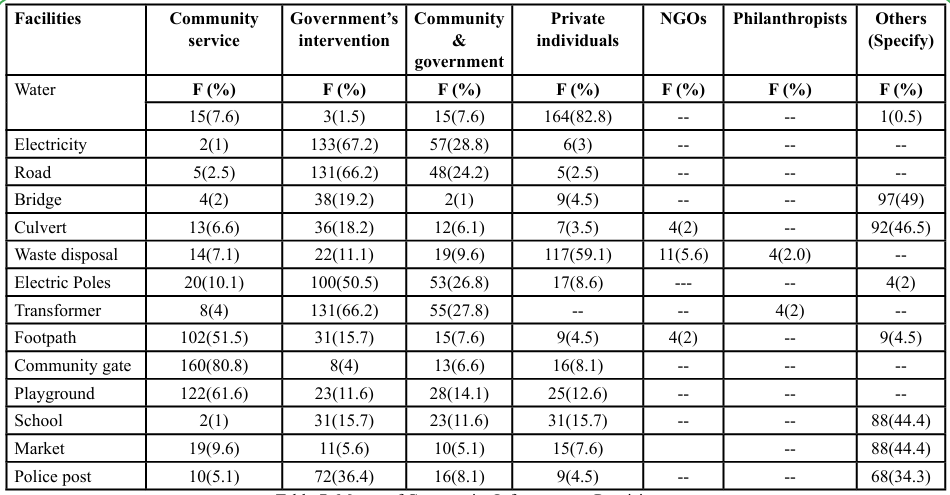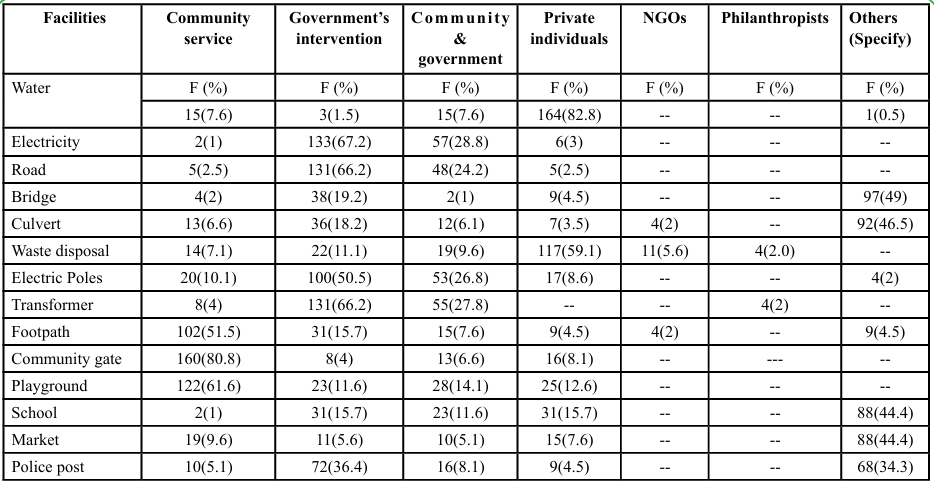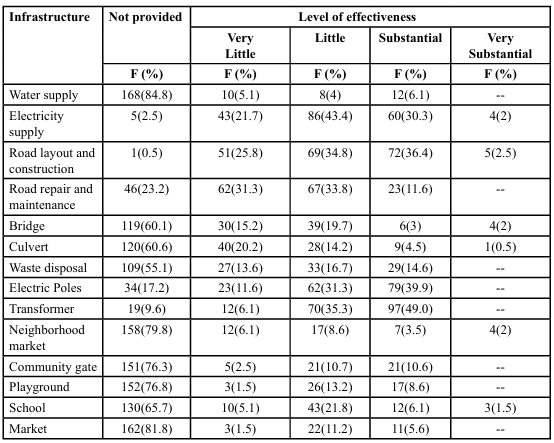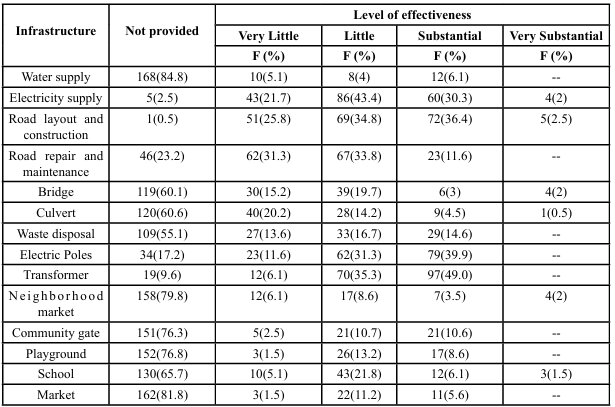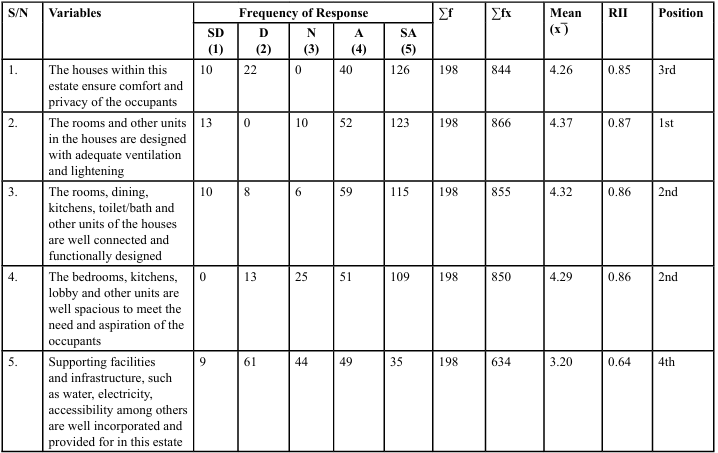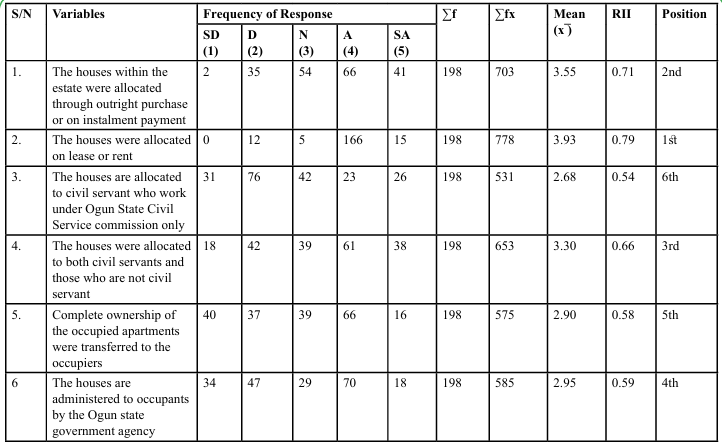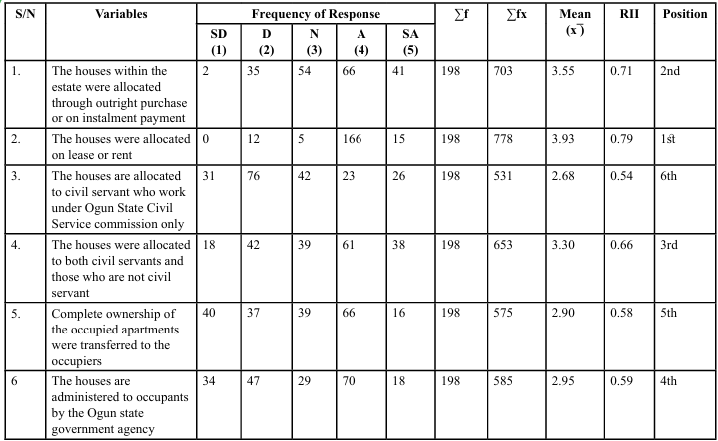Journal of Comprehensive Social Science Research Volume 3 (2025), Article ID: JCSSR-109
https://doi.org/10.33790/jcssr1100109Research Article
Planning and Administration of Public Housing in Ogun State, Nigeria
Wakeel Olorunwa Salau1* & Omoniyi Oluwatosin Elizabeth2
1Department of Geography, Obafemi Awolowo University, Ile-Ife, Nigeria.
2Department of Urban and Regional Planning, Lead City University, Ibadan, Oyo State, Nigeria.
Corresponding Author Details: Wakeel Olorunwa Salau, Department of Geography, Obafemi Awolowo University, Ile-Ife, Nigeria.
Received date: 02nd April, 2025
Accepted date: 26th June, 2025
Published date: 28th June, 2025
Citation: Salau, W. O., & Elizabeth, O. O., (2025). Planning and Administration of Public Housing in Ogun State, Nigeria. J Comp Soc Sci Res, 3(1): 109.
Copyright: ©2025, This is an open-access article distributed under the terms of the Creative Commons Attribution License, which permits unrestricted use, distribution, and reproduction in any medium, provided the original author and source are credited.
Abstract
This study examined the inventory of public housing estates, their administration, and the residents’ satisfaction in Abeokuta, Southwestern Nigeria. This is aimed to provide a comprehensive analysis of public housing estates’ composition, administration, residents’ perception, and community-based management approaches to maintaining public infrastructure. Quantitative survey research design was employed through the administration of 198 copies of questionnaire using multi-stage sampling. Data collected were analysed using frequency, percentage, and Relative Importance Index (RII). The results of the analysis showed salient factors influencing public housing choices in Abeokuta, focusing on socio economic characteristics and infrastructure. It was established that 51.5% of respondents lived in medium-density housing, indicating its prevalence. Also, 89.9% of the respondents indicated the usage of their buildings for administrative purpose, as majority of the buildings within the selected estates were indicated to have between one to two rooms, offices and shops. The gender distribution of the residents were nearly equal, with 52.5% males. Respondents’ marital status influenced housing preferences, as 65.2% of them were married. Educational attainment was high, with 60.6% being graduates, reflecting a well-educated population. The study also revealed that 87.4% are of Yoruba ethnicity, showing cultural homogeneity. Infrastructure provision, including water and electricity, was critical, though gaps remained in markets and recreational facilities. The findings underscored the significance of government and community involvement in infrastructure management.
Keywords: Housing, Planning, Administration, and Public Housing Estate
Introduction
Planning is the spatial arrangement of land uses to create orderly, economical, functionally efficient, and aesthetically pleasing environments for work, recreation, and circulation [1]. It is both an art and a science, aimed at optimizing the use of land and the placement of buildings and communication routes to achieve the highest possible levels of economy, convenience, and beauty [2-4]. Administration, on the other hand comprises a range of activities related to organizing, supervising, and managing [5]. Planning and administration, particularly in the context of housing, are interconnected activities that involve organizing, supervising, and managing housing developments [6-8].
Housing is described as a functional structure equipped with essential physical and social infrastructure, such as roads, electricity, and toilet facilities, supporting the daily lives of individuals and communities [9,10]. It encompasses the construction, provision, and allocation of dwellings that offer comfort and shelter [11], alongside basic amenities necessary for habitation [12]. Housing can broadly be classified into private, social, and public categories [13]. In Nigeria, private housing consists of commercially developed estates by individuals or corporate entities for profit. Social housing, on the other hand, refers to subsidized rental housing intended for vulnerable or disadvantaged populations, often provided as a form of temporary or emergency accommodation. This may include government or donor-led interventions for internally displaced persons, disaster victims, or urban poor populations.
A point of dissimilarity needs to be made between social housing and public housing in the Nigerian context, terms often used interchangeably in other countries but conceptually distinct in Nigeria. While social housing provides transitional assistance as part of social welfare policy, public housing in Nigeria refers to government-initiated mass housing schemes that are typically longer-term in nature and target low- and middle-income earners. These schemes aim to address the country’s chronic housing deficit by offering affordable homeownership or rental opportunities to qualified applicants [10,14].
Public housing in Nigeria functions as a critical instrument of social policy, and its planning and administration are coordinated by several government agencies across federal and state levels. These include the Federal Housing Authority (FHA), State Housing Corporations, and Property Development Corporations. The FHA, established in 1973, is responsible for formulating and implementing federal housing policies and overseeing major estate developments such as FESTAC Town in Lagos. At the sub-national level, State Housing Corporations, like the Ogun State Housing Corporation (OGSHC), focus on regional housing provision, while Property Development Corporations often serve as implementation arms, responsible for construction, marketing, and sometimes maintenance of housing units. Although these agencies operate under separate administrative structures, overlaps in responsibilities, particularly in estate planning, allocation, and management, can culminate in fragmentation, inefficiency, and inter-agency conflicts.
The allocation process of public housing is typically based on applications vetted through criteria such as income level, occupation, household size, and sometimes political or civil service status. However, critics argue that allocation procedures lack transparency and are often influenced by political patronage and bureaucratic inefficiencies [15]. In Ogun State, public housing estates have expanded over recent decades in response to population growth and urbanisation pressures, but they continue to face multiple planning and administrative challenges. Studies by Ogunbayo et al. [16] and Orekan [17] reveal persistent issues such as poor infrastructure maintenance, limited funding, inadequate estate management, and disjointed policy implementation. These findings point to the urgent need for a comprehensive inventory of existing estates, evaluation of institutional roles and management frameworks, and active incorporation of residents’ perspectives in public housing design, allocation, and administration.
This study seeks to fill the vacuum in research on the planning and management of public housing in Abeokuta, Nigeria, by examining the inventory of public housing estates, their administration, and residents’ satisfaction. The study aims to provide a comprehensive analysis of the public housing estates' composition, administration, residents' perceptions, and community-based management approaches to maintaining public infrastructure.
Study Area
This study was conducted in Abeokuta, Ogun State, Nigeria. Abeokuta is a capital city located in the south-western part of Nigeria. It lies on latitude approximately located within latitude 7˚0'0 N and 7˚ 20' 0 North of the equator and 3˚0'0 E and 3˚20'0 East of the Greenwich meridian [18]. The study area is strategically located between major towns and cities such as Lagos, Ibadan, Ijebu-Ode, Sagamu, Sango Ota, Papalanto and Ilaro. The study area is about 81km south-west of Ibadan; the capital of Oyo State and 106km North of Lagos State. (See figure. 1). Abeokuta is an essential commercial hub renowned for its rich history and cultural heritage. The city's strategic location and historical significance have contributed to its steady population growth and urban expansion. Consequently, Abeokuta faces considerable housing challenges, including inadequate housing stock, poor infrastructure, and inefficient management of public housing estates [19,20]. Abeokuta's public housing landscape comprises various estates managed by state and federal agencies, including the Housing Corporation, Property Development Corporation, and Federal Housing Authority. These agencies are responsible for planning, developing, and managing housing estates to address the needs of the low-income population. However, the rapid urbanization and population increase have strained these public housing estates, leading to issues such as overcrowding, inadequate maintenance, and substandard living conditions [21].
Methodology
This study predominantly employed survey research design to investigate planning and administration of public housing in Abeokuta, Southwestern Nigeria. Data were collected from primary and secondary sources. Primary data were collected through questionnaire administration while secondary data were collected from journal publications and published reports to discuss the findings of this study. Also, the population of this study comprises the residents of the various public housing estates in Abeokuta, Ogun State, Nigeria. However, due to homogenous population model, a sizable portion of the population was sampled to avoid repetition. The homogeneous nature of this population is characterised largely by similarities in demographic profiles (e.g., age distribution, household size), socio-economic status (primarily low- to middle-income groups), and residential characteristics (i.e., all living in government allocated public housing units). In consequent, a homogeneous population model was adopted to ensure efficient sampling and to avoid redundancy in responses. In this context, the term refers to the relative uniformity among residents in terms of their income levels, access to housing services, and shared experiences within public housing settings.
Multistage sampling was adopted for this study. The stage involved identification of all the public housing estates in Abeokuta, Ogun state Nigeria (Table 1). The second stage of sampling technique involved adoption of sampling method to select five public housing estates based on principle of homogenous model to avoid repetition (Table 2). The third stage involved the stratification of respondent based on the categories of selected public housing estates. Similarly, based on homogenous population model 198 respondents were samples using snowball approach through online questionnaire administration. However, due to the low turnout at earlier stage of the online questionnaire administration with the request of some of the estates’ residents to have printed copies of questionnaire, field survey was embarked on to complement the online survey. Hence, 198 copies of questionnaire were administered to the selected estates.
The data collected for this study were analyzed using descriptive statistics. The descriptive statistics employed were frequency distribution, percentage and Relative Importance Index (RII). Frequency distribution and percentage were used to measure demographic attributes of the respondents while the relative Importance index (RII) was employed for Likert Scale data.
The RII was used to analyse all the ordinal (scale) data collected in this study. The RII evolved from the ratings of five Likert scales adopted in this study. To examine the respondents’ perception on the design, planning and management of public housing estate in the study area, respondents were provided with a list of variables on design and variables on planning and management to indicate their perceived ratings on five-point Likert scale of Strongly Disagree, Disagree, Neither agree nor disagree, Agree and Strongly Agree. The results of the analysis evolved into sum of the weight values (∑fx) and average mean of the weighted value. The result further evolved into a measure called Relative Importance Index (RII). The Relative Importance Index were expressed as:
RII= ∑fx/(A×N) (1)
This expression showed that formula for the computation of RII, such that ∑fx represents sum of the weighting assigned to each of the identified variables. The A in the equation represented the highest rating of respondents’ response on five-point Likert Scale (i.e., 5 to 1) employed in Questionnaire administration while the N represented total respondents. Thus, the five Likert scale of ratings were assigned numerical values of 1, 2, 3, 4, and 5 respectively. The numerical value was transformed into 0.2 (1/5), 0.4 (2/5), 0.6 (3/5), 0.8 (4/5), and 1.0 (5/5) respectively for 0 ≤ RII ≤1.
Results
Respondents Socio-economic Characteristics
In this study, housing density refers to the number of housing units per plot of land or the number of persons accommodated per residential building within a specific estate. The classification into low, medium, and high density was based on planning and design standards provided by the Ogun State Housing Corporation, where:
• Low density refers to single-family detached houses with spacious plots and fewer occupants per building,
• Medium density includes semi-detached houses or terrace units accommodating multiple families but with moderate spacing, and
• High density includes multi-unit apartment blocks or flats with limited space per household and higher occupancy per building.
The combined categories (e.g., "Low and medium", "Medium and high") reflect estates or sections within estates where multiple housing types with varying densities coexist.
The socio-economic attributes of the respondents are provided in Table 3 with the results of the analysis. Prior to the socio-economic characteristics, the density of the housing units is indicated. It was discovered that the majority of the housing units within the public housing estates were of medium density, accounting for 51.5% (102) of the respondents. Next in magnitude was 19.2% (38) of the respondents who lived in high-density units, while the remaining 29.3% lived in a mix of low, medium, and high-density housing combinations. Also, of all the four public housing estates surveyed, respondents living in Media Village accounted for 83.3% of the total respondents, while others resided in Ajebo Road Housing Estate, Obasanjo Hill-top Estate, and Olokemeji Housing.
The gender distribution of respondents shows that 52.5% (104) were males and 47.4% (94) were females. This is relatively consistent with the gender composition of the general population in Abeokuta and Ogun State, where male and female ratios are nearly equal according to the National Bureau of Statistics (NBS, 2020). Majority of respondents (65.2%) were married, while 10.1% were separated/ divorced, 13.1% single, and 11.6% widowed. In terms of educational attainment, 60.6% of respondents were graduates, and 30.3% held postgraduate degrees. This is notably higher than Ogun State’s general population, where tertiary education attainment remains below 30% (NBS, 2020), indicating that public housing residents in Abeokuta, particularly in government-allocated estates, tend to have higher educational qualifications, possibly due to civil service-based housing allocations.
Occupationally, respondents were mainly employed in the civil service (35.4%) and private sector (28.3%), followed by artisanship, trading, and other categories. This suggests that public housing estates in Abeokuta are largely populated by formally employed middle-income earners, especially public servants, which aligns with state housing allocation policies that prioritise government employees. In terms of income, most respondents reported average monthly earnings between ₦60,000 and ₦150,000, placing them in the middle-income bracket by national standards. This again contrasts with Ogun State’s general income distribution, where many informal sector workers earn below ₦50,000 monthly (NBS, 2020), highlighting the economic selectivity of public housing allocation in the study area.
Ethnically, the respondents were predominantly of Yoruba origin (87.4%), with only 12.6% identifying as Igbo. This closely reflects the ethnic composition of Abeokuta and Ogun State, where the Yoruba ethnic group constitutes the majority. However, the underrepresentation of other ethnic minorities suggests limited diversity within public housing settlements, possibly due to regional housing policies or social preferences.
On length of residence, most respondents had lived in the estates for 0–5 years (26.8%) and 11–15 years (15.7%), reflecting a mix of new and relatively long-term residents. Security and safety were cited as the main reasons for choosing to live in the estates. Other reasons included affordability, serene environment, proximity to work, and location. Findings also showed that household sizes clustered around 5 to 6 members (38.9%), 3 to 4 (36.9%), and 1 to 2 (19.2%), with an average family head age of 46 years. This mirrors the broader Nigerian urban household structure, which often comprises extended or nuclear families averaging 4–6 persons. These findings align with previous studies, such as Bryson [7], which showed that safety, income level, and marital status play crucial roles in residential decision-making within public housing environments, in addition to the availability of infrastructure.
Respondents’ Building Elements and Characteristics
Table 4 presents information on the attributes and elements of the buildings occupied by the respondents within the estates. It was discovered that majority of the respondents used the buildings they occupied within the estate for residential use and this accounted for 89.9% (178) of the total respondents. While others utilized the occupied buildings of the estate for commercial only, residential and commercial, and residential and public. Also, majority of the respondents indicated that their public buildings within their various estates were used for administrative use (86.3%) while the lowest respondents indicated that theirs were used for recreational use (1%) and others indicated that theirs were used for education, religions and others which jointly accounted for 12.6%. Also, on building types, it was discovered majority of the respondents indicated that their occupied building types were majorly 2-bed room flat and 3-bedroom flat which accounted for 46.9% and 35.9% respectively. On number of floors, all the respondents indicated varied number of floors which ranged from one to eight and others while the proportion that indicated others accounted for largest. Besides, majority of the buildings within the selected estates were indicated to have between one to two rooms, offices and shops. On the buildings ages, it was established that majority of the buildings within the estates were 11 to 30 years and accounted for 80.3%. Also, findings indicated majority of the respondents who were residents of the various selected housing estates were on private renting and this accounted for 55.1%.
Estate Planning and Administration of the Selected Housing Estate
Findings revealed that 52.5% of the respondents indicated that their housing estates got building approval while only 2% of the total respondents indicated that their housing estates had no approval for buildings within the estates. Similarly, 45.5% of the total sampled population indicated that their estates did not alter their building design after the approval before the construction. However, 94.9% of the total respondents indicated that only roof renovation was the only form of amendment done within their estates after the construction. Similarly, 33.8% of the total respondents indicated that their estates procured or had certificate of occupancy while majority of the respondents indicated that they were devoid of such knowledge and this accounted for 52.1% and 14.1% indicated that theirs had no certificate of occupancy. Also, it was discovered that majority of the housing estates had no approval from town planning authority and this accounted for 78.8% while only 21.2% procured their approval from town planning authority as indicated by the respondents.
Availability and Management of Public Infrastructure
The public infrastructural system within the estate was investigated and ten infrastructural facilities were identified within the estates. It was established that there was proliferation of some public infrastructural such as water, electricity, roads, waste disposal, security, and landscaping, as majority of the respondents indicated the availability of these infrastructural facilities in their residing public housing estate (Table 6). It was established that infrastructure like market, education, drainage, and recreation were not profound in the selected estate and this accounted for lower proportion of the respondents that indicated their availability.
Furthermore, Table 7 presents information on the way to which the community infrastructure within the housing estates is provided in the selected estates in Abeokuta. It was established that water was majorly provided by the private individuals, as indicated by 82.8% of the respondents. While few of the public housing estates sampled had their water facility or infrastructure being provided by community service, and community and government which jointly accounted for 7.6% each. The electricity and roads in the estates were majorly provided through government intervention and these were indicated by 67.2% and 66.2% of the total respondents. Similarly, waste disposal was provided by private individuals (59.1%) while the electric poles and transformers within the estates were provided by government intervention and these accounted for 50.5% and 66.2% respectively. Besides, it was established that most of the footpaths, community gates, and playground were provided through community service. However, majority of the respondents indicated that some infrastructure like bridge, culvert, market and schools were provided from other means.
On the provision, management and maintenance of the identified community infrastructure, Table 8 presents information in this regard. It was recorded from the analysis that water in the community was being managed and maintained by private individual and this accounted for 82.8% of the respondents’ indication. The electricity and roads were being managed and maintained through government intervention. Bridge, culvert, school, and market were managed and maintained through other means other than those identified in Table 8. Besides, electric poles and transformers were managed and maintained through government intervention as they were the provided of the facilities while waste disposal was managed and maintained by private individuals. In addition, community service was used as a medium or way through which footpaths, community gate, and playground were managed within the housing estate. More importantly, on the involvement of the community in the funding and implementation of community infrastructure in the housing estate, it was established that there was moderate form of involvement of the community in funding and implementation of the identified infrastructure. Besides, majority of the respondents indicated that the community were moderately involved in the maintenance of the community infrastructure within the estates.
Residents’ Perception on Design, Planning, and Management of Public Housing Estate
It was established in this study that majority of the respondents rated government administration and management of public housing estate as fair within the estate. Also, on the planning and layout of the housing estates, it was discovered that government efforts in this regard were rated as being fair in the study area (Abeokuta). Similarly, the effectiveness of the earlier identified infrastructural facilities was provided in Table 9, it was established that water, bridge, culvert, waste disposal, community gate, playground, school, market, and neighborhood market were not publicly provided by government intervention, community service or any other institutional means rather it was privately provided and this made the respondents mostly rated it as, not provided. Electricity, and road repair and maintenance were majorly rated by respondents as being little in their effectiveness while electric poles, transformers, road layout and construction were rated as being substantial in their effectiveness.
Furthermore, to examine the respondents’ perception on the design, planning and management of public housing estate in the study area, respondents were provided with a list of variables on design (Table 9) and variables on planning and management (Table 10) to indicate their perceived ratings on five-point Likert scale of Strongly Disagree, Disagree, Neither agree nor disagree (N), Agree and Strongly Agree. The results of the analysis evolved into weight value (∑fx) and average mean of the weighted value. The result further evolved into a measure called Relative Importance Index (RII). The Relative Importance Index were expressed as:
RII= ∑fx/(A×N) (1)
This expression showed that formula for the computation of RII, such that ∑fx represents weighting assigned to each of the identified variables. The A in the equation represented the highest rating of respondents’ response on five-point Likert Scale (i.e. 5 to 1) employed in Questionnaire administration while the N represented total respondents. Thus, the five Likert scale of ratings were assigned numerical values of 1,2,3, 4, and 5 respectively. The numerical value was transformed into 0.2 (1/5), 0.4 (2/5), 0.6 (3/5), 0.8 (4/5), and 1.0 (5/5) respectively for 0 ≤ RII ≤1. Consequently, the analysis evolved into relative importance index (RII) that ranged from 0.64 ≤ RII ≤ 0.87 and this indicated that majority of the respondents strongly agreed on the identified variables in Table 10 with the exception of the last variable with RII= 0.64 which indicated that the respondents were Neither agree nor disagree about the variable. Hence, the respondents strongly agreed that the housing estates were designed with comfort and privacy; adequate ventilation and lightening; the dining, kitchens, toilet/bath and other units of the houses are well connected and functionally designed; and bedrooms, kitchens, lobby and other units are well spacious to meet the need and aspiration of the occupants. While the respondents were Neither agree nor disagree if supporting facilities and infrastructure, such as water, electricity, accessibility among others are well incorporated and provided for in this housing estates in the study area.
However, on the planning and management of the estates, it was established that majority of the respondents strongly agreed that the houses were allocated on lease or rent and that houses within the estate were allocated through outright purchase or on instalment payment (as RII ≥ 0.71). While most of the respondents agreed that the houses were allocated to both civil servants and those who are not civil servant (RII= 0.66). While all the respondents were Neither agree nor disagree with other variables whose RII ≤ 0.59 (Table 10).
Discussion of Findings
The socio-economic characteristics and perceptions of residents in public housing estates in Abeokuta provides valuable insights into housing conditions and community dynamics. Most respondents live in medium-density housing (51.5%), indicating its prevalence and balance between affordability and space, as noted by Ebekozien [15]. Also, gender distribution was almost equal, with slightly more males (52.5%). With 65.2% married, there was a clear demand for family oriented housing, aligning with Bryson [7], who identified the impact of marital status on housing choices. The residents' educational background, with 60.6% being graduates and working in civil service and private sectors, points to a relatively educated urban population [22]. The Yoruba ethnicity dominates (87.4%), indicated cultural uniformity that might influence community cohesion and shared values. The average monthly income ranged from 60,000 to 150,000 Naira, reflecting a middle-income group similar to national trends where middle-income earners were prominent in public housing [23]. Also, majority of the respondents (89.9%) used their residences solely for living purposes, supporting the idea that public housing in Nigeria is primarily for residential needs [11]. The preference for 2-bedroom and 3-bedroom flats (46.9% and 35.9%, respectively) matches the demographic's needs for modest family units.
In addition, respondents reported adequate availability of essentials like water and electricity, but markets, education, and recreational facilities were trails behind housing provision [14]. The mix of private water provision (82.8%) and significant government involvement in electricity and roads (over 60%) indicated a combined approach to infrastructure management in Nigerian cities where public resources were limited [10]. Community involvement in infrastructure maintenance through private and communal efforts showed a participatory approach to managing public resources, consistent with Sun et al. [8] on community engagement's importance. Also, residents generally had positive views on design and planning, with high RII scores indicating satisfaction with aspects like comfort and privacy. However, uncertainty about supporting infrastructure pointed to ongoing challenges in comprehensive service provision [24]. Hence, the study emphasied the complexity of public housing dynamics in Abeokuta, mirroring broader trends in urban Nigeria where socio-economic factors, community participation, and government policies shape housing experiences [25]. These findings contribute to discussions on improving public housing management and infrastructure, crucial for enhancing urban living conditions.
Recommendations
This study provides several recommendations based on the findings. Firstly, it suggests seeking government financial support, community service, and NGO assistance to improve infrastructure such as water supply, bridges, drainage, and schools. Currently, these facilities are often privately provided, leading to inefficiencies. Additionally, reviewing the occupancy ratios of buildings in relation to their design and maintenance is essential. It is also recommended to set a threshold for household sizes to reduce density, thereby increasing the lifespan of the buildings and preventing stress on supporting infrastructure.
Conclusion
This study found that safety, security, income, and marital status significantly influence public housing choices, alongside available infrastructure. Effective infrastructure provision enhances residents' experience. Government involvement in maintenance, upgrades, and community service plays a crucial role in attracting residents. Comfort, privacy, ventilation, and the functional design of housing units, including spacious rooms and well-connected spaces, were vital for resident satisfaction. Most houses in the selected estates are allocated for lease or rent, with some available for outright purchase or instalment payment.
Acknowledgement:
Not Applicable
Author Contribution:
OOE contributed to the study conception, design, and collected the data, while SWO analysed the data, interpreted it with discussion of findings and written the entire manuscript.
Funding:
The research received no funding from external source
Data availability:
The data for this study is available from the corresponding author on reasonable request.
Declaration
Conflict of Interest:
The authors declare no competing interests Ethics approval and consent to participate: The study was approved by Lead City University. Informed Consent was obtained from all the participants.
Consent for Publication:
Not applicable. The manuscript does not contain personal data of any individual.
References
Konyango, C. O., Hayombe, P. O., & Owino, F. O. (2021). Effectiveness of planning tools in managing the spatial stability of peri-urban areas. View
Hersperger, A. M., Bürgi, M., Wende, W., Bacău, S., & Grădinaru, S. R. (2020). Does landscape play a role in strategic spatial planning of European urban regions? Landscape and Urban Planning, 194, 103702. View
Kaklauskas, A., Bardauskiene, D., Cerkauskiene, R., Ubarte, I., Raslanas, S., Radvile, E., ... & Kaklauskiene, L. (2021). Emotions analysis in public spaces for urban planning. Land Use Policy, 107, 105458. View
Ratcliffe, J., Stubbs, M., & Keeping, M. (2021). Urban planning and real estate development. Routledge. View
Gan, X., Zuo, J., Wu, P., Wang, J., Chang, R., & Wen, T. (2017). How affordable housing becomes more sustainable? A stake holder studies. Journal of Cleaner Production, 162, 427-437. View
Straub, A. (2004, July). Housing management and maintenance practice of Dutch housing associations. In Proceedings of the ENHR 2004 Conference, Cambridge, UK (pp. 2-6). View
Bryson, J. M. (2018). Strategic planning for public and nonprofit organizations: A guide to strengthening and sustaining organizational achievement. John Wiley & Sons. View
Sun, Y., Hein, C., & Song, K. (2019). Planning of public housing in modern Tianjin (1928 1945). Planning Perspectives, 34(3), 439-462. View
Ezeanah, U. (2021, March). Quality housing: Perception and insights of people in Benin city, Nigeria. In Urban Forum (Vol. 32, No. 1, pp. 87-110). Dordrecht: Springer Netherlands. View
Salau, W. O., Unuigboje, R., & Olajide, O. (2023). Residents’ perception of housing quality in selected informal settlement in a part of Southwestern Nigeria. SN Social Sciences, 3(8), 136. View
Moore, E. A. (2019). Addressing housing deficit in Nigeria: Issues, challenges and prospects. Economic and financial review, 57(4), 15. View
Oni-Jimoh, T., Liyanage, C., Oyebanji, A., & Gerges, M. (2018). Urbanization and meeting the need for affordable housing in Nigeria. Housing, Amjad Almusaed and Asaad Almssad, IntechOpen, 7(3), 73-91. View
Wu, K. (2019). Housing reform, life course and urban housing acquisition (1980-2010). The Journal of Chinese Sociology, 6(1), 15. View
Ocholi, S., Manase, D., Lowe, J., & Sommerville, J. (2015). critical review of Nigeria national housing policies delivery (NNHPD). International Journal of Engineering Research & Technology, 4(9), 718-724. View
Ebekozien, A. (2021). A qualitative approach to investigate low-cost housing policy provision in Edo State, Nigeria. International Planning Studies, 26(2), 165-181. View
Ogunbayo, B. F., Alagbe, O. A., Ajao, A. M., & Ogundipe, E. K. (2016). Determining the individual significant contribution of public and private sector in housing delivery in Nigeria. British Journal of Earth Sciences Research, 4(3), 16-26. View
Orekan, A. A. (2019). A Review of Public Housing Delivery System in Ogun State, Nigeria. International Journal of Property Sciences (E-ISSN: 2229-8568), 9(1), 53-63. View
Ratcliffe, J., Stubbs, M., & Keeping, M. (2021). Urban planning and real estate development. Routledge. View
Akinpelu, O. P., Simon, R. F., Owolabi, M. A., & Sotayo, I. L. (2021, March). Evaluating solid waste storage and collection practices in Traditional Residential Area of Abeokuta Metropolis, Ogun State, Nigeria. In IOP Conference Series: Materials Science and Engineering (Vol. 1036, No. 1, p. 012010). IOP Publishing. View
Odekunle, J. F., & Adebayo, G. O. (2022). Assessment of compliance with development regulations in Abeokuta-West zonal planning area, Nigeria. Covenant Journal of Research in the Built Environment. View
Aliu, I. R. (2023). Social Policy, Public Housing, and Poverty Alleviation in Nigeria. In The Routledge Handbook of Poverty in the Global South (pp. 48-73). Routledge India. View
Jiboye, A. D., Adebayo, J. A., & Obakin, O. A. (2020). Urban housing in Nigeria for sustainable development: Challenges and prospects. International Journal of Advanced Engineering Research and Science, 7(7), 478-491. View
Ibem, E. O., Anosike, M. N., & Azuh, D. E. (2011). Challenges in public housing provision in the post-independence era in Nigeria. Journal of Human Sciences, 8(2), 421-443. View
Ekpo, A. (2019). Housing deficit in Nigeria: Issues, challenges and prospects. Economic and financial review, 57(4), 13. View
Walker, A. P. P. (2016). Self-help or public housing? Lessons from co-managed slum upgrading via participatory budget. Habitat International, 55, 58-66. View
Ebekozien, A. (2020). Community participation in affordable housing provision in developing cities: a study of Nigerian cities. Journal of Human Behavior in the Social Environment, 30(7), 918-935. View









